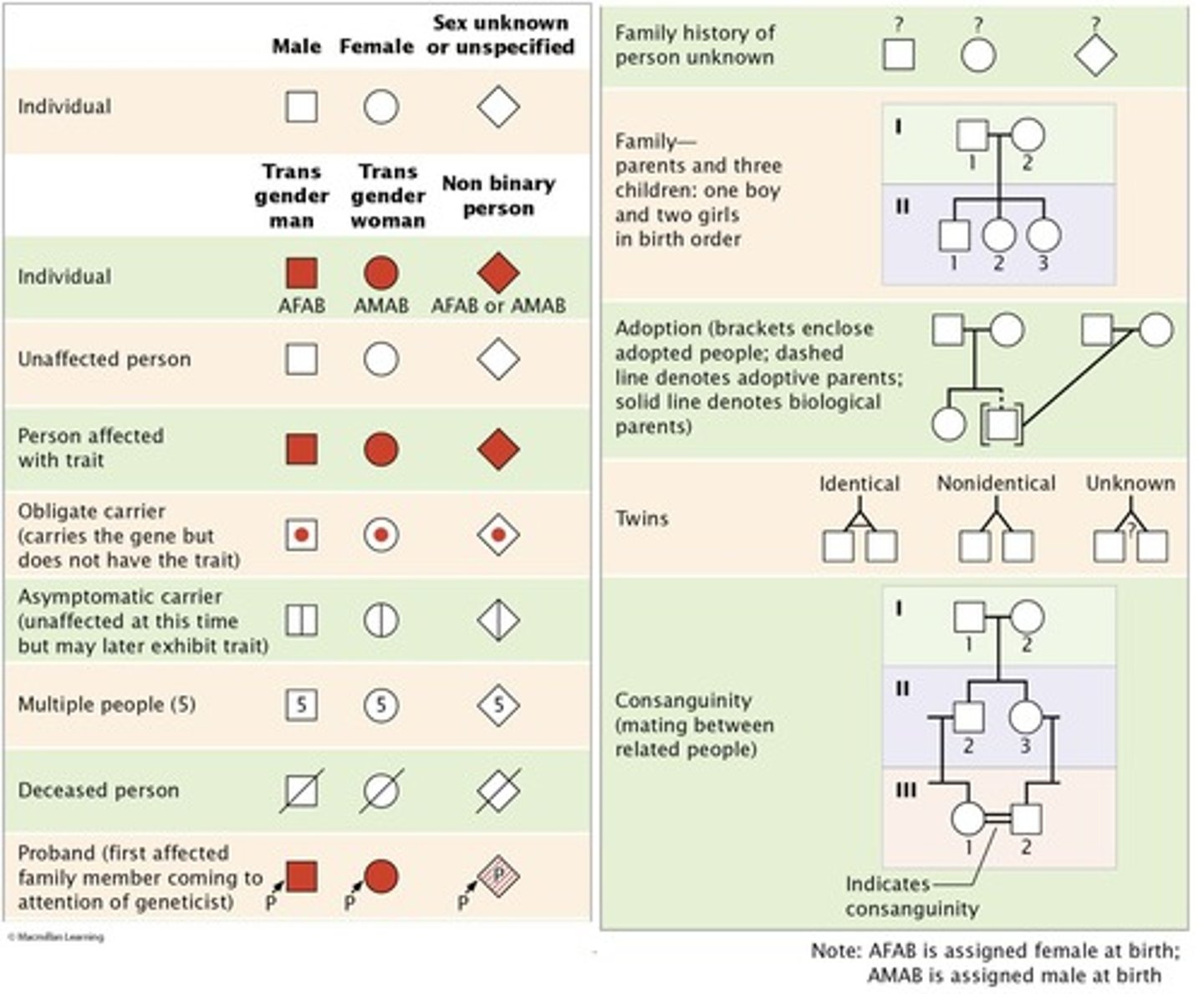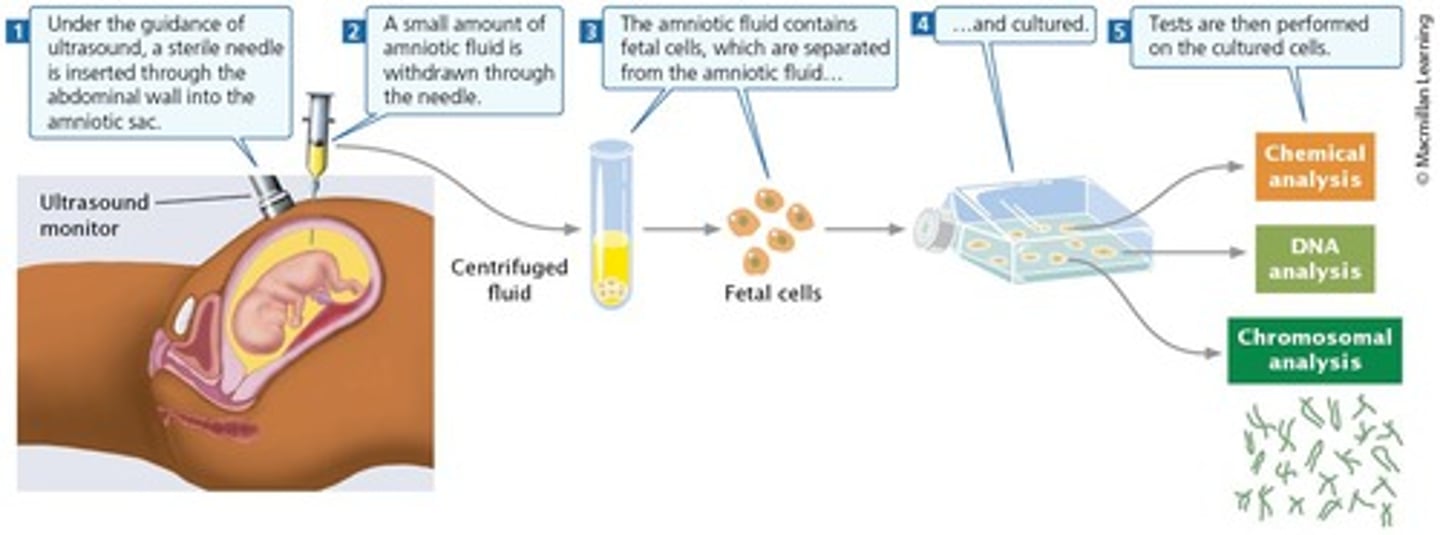Genetics Pedigree Analysis and Inheritance Patterns in Humans (CH6)
1/124
There's no tags or description
Looks like no tags are added yet.
Name | Mastery | Learn | Test | Matching | Spaced |
|---|
No study sessions yet.
125 Terms
Pedigree
Pictorial representation of a family history; a family tree that outlines the inheritance of one or more characteristics.

Proband
The person from whom the pedigree is initiated.
Autosomal recessive traits
Traits that tend to skip generations and appear only when both parents carry a copy of the gene for the trait, which is more likely when the parents are related.
Familial hypercholesterolemia
An autosomal dominant condition where blood cholesterol is greatly elevated due to a defect in the LDL receptor.
Autosomal dominant trait
A trait that might skip generations when a new mutation arises or the trait has incomplete penetrance.
Cystic fibrosis (CF)
A condition that is autosomal recessive, indicated when the CF phenotype is not present in parents but appears in one of their children.
Controlled mating
Not possible in human genetics, making the study of inheritance challenging.
Long generation time
A characteristic of human biology that complicates genetic studies.
Small family size
A feature of human biology that limits the study of genetics.
Consanguine mating
Mating between relatives, which increases the likelihood of autosomal recessive traits appearing in pedigrees.
X-linked recessive traits
Traits that are passed down through the X chromosome and can affect males and females differently.
X-linked dominant traits
Traits that are expressed in individuals with only one copy of the gene on the X chromosome.
Y-linked traits
Traits that are passed down through the Y chromosome and affect only males.
Testcross
A genetic cross used to determine the genotype of an individual with a dominant phenotype.
Generation time
The average time between the birth of an individual and the birth of its offspring.
Inheritance of characteristics
The transmission of traits from parents to offspring, often studied through pedigrees.
Human genetics challenges
Include the impossibility of controlled matings, limited family sizes, and short generation times.
Phenotype
The observable characteristics or traits of an individual, which can be influenced by genetics.
Genetic testing
The analysis of DNA, RNA, chromosomes, proteins, and metabolites to detect genetic disorders.
Mutation
A change in the DNA sequence that can lead to genetic variation or disease.
Penetrance
The proportion of individuals with a particular genotype that actually express the associated phenotype.
Autosomal traits
Traits that are determined by genes located on autosomes, not sex chromosomes.
Alexander disease
An autosomal dominant trait that can skip generations.
X-linked recessive trait
A trait that is more commonly seen in males and is passed from mothers to sons.
X-linked dominant trait
A trait that affects offspring with a 1/2 probability for both sons and daughters if the father is affected.
Characteristic of X-linked recessive traits
The trait can skip a generation and is more commonly seen in males.
Higher penetrance in males
A scenario where an autosomal recessive trait is more frequently expressed in males than in females.
Proportion of offspring affected by X-linked dominant trait
1/2 sons and 1/2 daughters will be affected if the father has the trait.
Trait transmission in X-linked recessive inheritance
The trait is not passed from fathers to sons.
Affected son's mother in X-linked recessive trait
An affected son's mother either has the trait or is heterozygous (carrier).
Conclusion from X-linked dominant trait study
If none of the sons have the trait and all daughters do, the mother has the X-linked dominant trait.
Mutation origin in X-linked traits
The mutation likely arose during meiosis of either parent.
Trait skipping generations
Common in autosomal dominant traits, indicating incomplete penetrance.
Characteristic NOT expected in X-linked recessive pedigree
The trait is commonly passed from fathers to sons.
Environmental influence on Alexander disease
Only the environment can cause Alexander disease.
Reasoning for trait skipping a generation
No reasoning could explain this if Alexander disease is autosomal dominant.
X-linked dominant trait inheritance
A male affected with an X-linked dominant trait will pass it to all daughters and none of his sons.
X-linked recessive trait characteristic
Whenever a daughter receives the trait, the father is affected.
X-linked dominant trait conclusion
If the father has the trait, he will pass it to all daughters.
Autosomal recessive trait vs X-linked recessive trait
X-linked recessive traits are only passed to sons from mothers, not from fathers.
Affected offspring from X-linked dominant parent
1/2 of the offspring will be affected if the father has the trait.
X-linked dominant trait in family study
The father has the X-linked dominant trait if none of the sons have it and all daughters do.
Y-linked trait
A trait that is passed from fathers to sons only.
Genetic mosaicism
A condition where an individual has somatic cells that are genotypically different from one another.
Concordant trait
The trait shared by both members of a twin pair.
Concordance
The percentage of twin pairs that are concordant for a trait.
Dizygotic twins
Nonidentical twins.
Monozygotic twins
Identical twins.
Autosomal recessive trait
A trait that can skip generations and may appear in offspring if both parents are carriers.
In vitro fertilization
A process where several eggs are fertilized outside the body before being implanted.
Somatic cells
Cells that make up the body tissues and organs, excluding germ cells.
Embryogenesis
The process of development of an embryo from the fertilization of the egg to the formation of a fetus.
Twin studies
Research studies that compare the traits of twins to assess the influence of genetics and environment.
Mosaicism
A genetic condition resulting from abnormal separation of chromosomes during early embryogenesis.
Genetic makeup
The unique combination of genes that an individual possesses.
Fetus
An unborn offspring in the later stages of development, after the embryonic stage.
Conjoined twins
Twins that are physically connected to each other at birth.
Abnormal separation of chromosomes
A process that can lead to genetic mosaicism.
Affected heterozygous males
Males who carry one copy of a dominant allele for a trait.
Genetic inheritance
The process by which genetic information is passed from parents to offspring.
Concordance rate of cancer in monozygotic twins
12%
Concordance rate of cancer in dizygotic twins
15%
Concordance rate of epilepsy in monozygotic twins
59%
Concordance rate of epilepsy in dizygotic twins
19%
Genetic component of epilepsy
Epilepsy has a strong genetic component.
Environmental component of asthma
Asthma is linked strongly to an environmental component.
Concordance of traits
A trait exhibits 100% concordance in both monozygotic and dizygotic twins.
Importance of genes and environment
Studying twins and adoptions can help assess the importance of genes and environment.
Interpretation of low concordance values
Such low values make interpretation difficult.
Genetic factors in cancer occurrence
The occurrence of cancer is mostly linked to genetic factors.
Environmental factors in cancer occurrence
The occurrence of cancer is mostly linked to environmental factors.
Equal influence of factors in cancer
The occurrence of cancer is linked equally to both genetic and environmental factors.
Single gene causation
Epilepsy is not caused by a single gene.
Penetrance of epilepsy
Epilepsy is not 100% penetrant.
Asthma in adopted children
If adoptive parents develop asthma, then their adopted child is more likely to have asthma.
Genetic factors in asthma
Asthma is linked strongly to a genetic component.
Concordance in monozygotic twins
Monozygotic twins tend to look more similar.
Concordance in dizygotic twins
Dizygotic twins share only 50% of their genes on average.
Study of twins and adoptions
Can help assess the importance of genes and environment.
Cancer interpretation
The occurrence of cancer is linked equally to both genetic and environmental factors.
Genetic factors are extremely important.
A conclusion drawn when a trait exhibits 100% concordance in both monozygotic and dizygotic twins.
Genetic factors are somewhat important.
A conclusion drawn when a trait does not exhibit 100% concordance in both monozygotic and dizygotic twins.
Genetic factors are unimportant.
A conclusion drawn when environmental factors are determined to play a larger role than genetic factors.
Both genetic and environment factors are important.
A conclusion drawn when both types of factors contribute to the differences in a trait.
Adoption studies assumptions.
Adoptees have no contact with their biological parents after birth, the adoptive parents and biological parents are not related, and the environments of biological and adoptive parents are independent.
Genetic counseling.
Provides information related to hereditary conditions.
Reasons for seeking genetic counseling.
Genetic disease runs in the family, help is needed in understanding the results of a prenatal test, parents know they are carriers for a recessive disease, and the members of a couple are closely related to each other.
Considerations before genetic testing.
Genes at other loci could cause the disease, the disease may be influenced by environmental factors, and the disease may not be 100% penetrant.
A sample of fetal blood.
Obtained by inserting a needle into the umbilical cord.
Adermatoglyphia (ADG).
An autosomal dominant disorder characterized by the absence of fingerprints.
Hallmark of adermatoglyphia.
Individuals with the condition have a parent with the condition.
Autosomal dominant disorder.
A disorder that is seen more commonly in males than females and skips generations.
Fingerprints in adermatoglyphia.
Individuals with the condition have fingerprints that are all whirls.
Higher concordance for monozygotic twins than for dizygotic twins
Indicates that the environment is not involved in the condition.
Cohort of adopted children with OCD
Indicates a genetic component when biological parents have OCD but adoptive parents do not.
Genetic Counseling and Genetic Testing
Provide information to those concerned about genetic diseases and traits.
Preimplantation genetic diagnosis
Determines the presence of disease-causing genes in an embryo at an early stage, before it is implanted in the uterus.
Prenatal genetic testing
Determines the presence of disease-causing genes or chromosomes in a developing fetus.
Amniocentesis
Involves withdrawing amniotic fluid from the uterus, not the fallopian tubes, to perform prenatal testing on fetal tissue.

Tay-Sachs disease
An autosomal recessive condition that can be tested for using chorionic villus sampling.